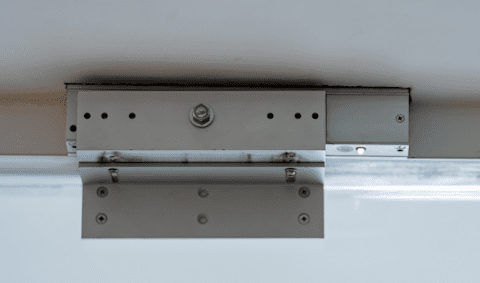Electromagnetic Door Locks - GeoArm Security®
Free for orders $200 & above!
Electromagnetic Door Locks
Unauthorized Entry Protection!
An electromagnetic door lock, also known as a maglock, is a locking mechanism that consists of an electromagnet and an armature plate. When the power is on, the electromagnet attracts the metal plate, which is attached to the door, and locks the door securely. These locks are used for securing various types of doors, including entrance doors, interior doors, emergency exits, and gates. They are widely used in high-security buildings such as banks, hospitals, government offices, data centers, daycares, schools, and other commercial facilities. Maglocks offer a secure locking option because they cannot be picked like traditional locks, and they are highly resistant to forced entry.
The strength of an electromagnetic lock is often measured in pounds of holding force (or pounds of pressure). The holding force of an electromagnetic lock can range from a few hundred to over a thousand pounds, depending on the size and power of the lock. It's important to note that the holding force is not the same as the breaking force, which is the amount of force required to break the lock or overcome its holding force.
Electromagnetic door locks are a great choice to lock down schools in the event of an active shooter on premise. These locks can be activated quickly and easily by pressing a button or flipping a switch, which can help to keep students and staff safe in the event of an emergency.

Common Uses for Electromagnetic Door Locks?
1. Access Control - They are frequently used in access control systems to secure doors in commercial buildings, offices, and restricted areas. They can be integrated with security systems to control entry.
2. Emergency Exits - In some configurations, electromagnetic locks are used on emergency exit doors. They can be set to release automatically in case of a fire alarm or power failure, ensuring safety compliance.
3. High-Security Areas - Due to their strong holding force, maglocks are ideal for securing high-security areas such as server rooms, laboratories, and vaults.
4. Automatic Doors - Often used in conjunction with automatic sliding or swinging doors to ensure they remain securely closed when not in use.
5. Interlocking Systems - In facilities requiring controlled access, such as cleanrooms or laboratories, these locks can be part of an interlocking system where one door cannot be opened until another is closed.
6. Residential Security - While less common, some residential properties use maglocks for added security on gates or main entry doors.
7. Retail and Hospitality - In retail and hospitality settings, maglocks can be used to secure back-of-house areas, stockrooms, or staff-only zones.
Installation Tips for Electromagnetic Door Locks?
1. Choose the Right Maglock - Ensure you select a maglock that is suitable for the door type and the level of security required. Consider factors like holding force, size, and power requirements.
2. Proper Alignment - Ensure that the armature plate and the magnet are perfectly aligned. Misalignment can lead to reduced holding force and ineffective locking.
3. Secure Mounting - Use the appropriate mounting brackets and hardware to securely attach the maglock to the door frame and the armature plate to the door. This ensures stability and reliability.
4. Power Supply - Ensure that the power supply is adequate for the maglock's requirements. Maglocks typically require a continuous power supply, so consider using a dedicated power source.
5. Wiring Considerations - If wired, use the correct gauge of wire for the distance between the power source and the maglock. Ensure all connections are secure and protected from tampering.
6. Test the System - After installation, thoroughly test the maglock to ensure it locks and unlocks as expected. Check for any issues with alignment or power supply.
7. Integration with Access Control - If the maglock is part of a security system, ensure it is properly integrated and configured.
8. Safety Features - Consider installing a release button or emergency exit device to allow for quick egress in case of an emergency.
9. Regular Maintenance - Schedule regular maintenance checks to ensure the maglock and its components are functioning correctly and to address any wear and tear.







